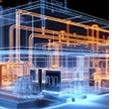 As summer approaches, so do concerns about keeping buildings cool and comfortable. Extreme heat can stress occupants, HVAC systems, and building automation systems. Let’s delve into the technical aspects of how high temperatures can affect these systems and explore strategies to mitigate negative impacts.
As summer approaches, so do concerns about keeping buildings cool and comfortable. Extreme heat can stress occupants, HVAC systems, and building automation systems. Let’s delve into the technical aspects of how high temperatures can affect these systems and explore strategies to mitigate negative impacts.
The Toll of High Temps on HVAC Systems
- Reduced Efficiency: According to the Department of Energy, extreme heat forces HVAC systems to work harder to maintain desired temperatures. This increased workload can decrease efficiency by up to 15%.
- Increased Wear and Tear: Components like compressors and condensers face greater stress when operating under high load. ASHRAE agrees that this can lead to premature component failure and costly repairs.
- Refrigerant Leaks: Extreme heat can exacerbate leaks in refrigerant lines, leading to reduced system performance and potential environmental hazards.
The Impact of High Temperatures on Building Automation Systems
- Sensor Malfunctions: Temperature sensors, a crucial component of BAS, can experience calibration drift due to excessive heat. The National Institute of Standards and Technology (NIST) backs up that this can lead to inaccurate data and hinder the system’s ability to optimize HVAC operation.
- Communication Disruptions: High temperatures can affect the reliability of communication cables and connections within the BAS. This can lead to data transmission errors and hinder the system’s ability to control HVAC equipment effectively.
- Overheating of Electronic Components: Extreme heat can stress electronic components within the BAS controller. In worst-case scenarios, this can lead to complete system failure.
Combating the Heat: Strategies for Protecting HVAC & Building Automation Systems
- Preventative Maintenance: Regularly schedule maintenance to ensure optimal performance of systems. The Department of Energy recommends cleaning condenser coils, checking refrigerant levels, and inspecting for leaks.
- Strategic Scheduling: Adjust HVAC and BAS operation during peak heat hours to minimize workload. Consider pre-cooling buildings at night when temperatures are lower.
- Upgrade to High-Efficiency Equipment: Investing in newer, energy-efficient HVAC systems can significantly reduce energy consumption and lessen the burden on the equipment during high temperatures.
- Proper BAS Design: Ensure proper ventilation and temperature control within BAS enclosures to prevent overheating of electronic components.
- Redundancy and Backup Systems: Implementing redundant communication pathways and backup power supplies can mitigate potential disruptions caused by extreme heat within a building automation system.
By understanding the impact of high temperatures and implementing proactive strategies, building owners and facility managers can ensure the smooth operation of both their HVAC and building automation systems throughout the summer months. This not only optimizes energy efficiency and minimizes repair costs but also guarantees a comfortable and healthy environment for building occupants.
Source online or call Kele today for help in getting ready for summer maintenance calls—we make it easy!





